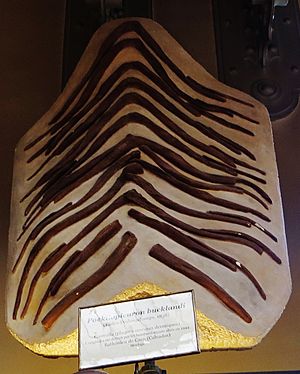Poekilopleuron facts for kids
Quick facts for kids Poekilopleuron |
|
|---|---|
 |
|
| Cast of the holotype gastralia, Muséum National d'Histoire Naturelle | |
| Scientific classification |
|
| Kingdom: | Animalia |
| Phylum: | Chordata |
| Clade: | Dinosauria |
| Clade: | Saurischia |
| Clade: | Theropoda |
| Family: | †Megalosauridae |
| Subfamily: | †Afrovenatorinae |
| Genus: | †Poekilopleuron Eudes-Deslongchamps, 1836 |
| Type species | |
| Poekilopleuron bucklandii Eudes-Deslongchamps, 1836
|
|
| Synonyms | |
|
Genus synonyms
Poecilopleuron Bronn, 1837 (nomen nudum)
Poikilopleuron Owen, 1842 Poecilopleurum Bronn, 1849 Poicilopleuron Joseph Leidy, 1870 Species synonyms
Poikilopleuron bucklandi Owen, 1842
Poecilopleurum bucklandi Bronn, 1849 Poicilopleuron bucklandi Leidy, 1870 Megalosaurus bucklandi Hulke, 1879 Megalosaurus poikilopleuron Huene, 1926 Poekilopleuron bucklandi White, 1973 Poecilopleuron bucklandi Welles & Long, 1974 |
|
Poekilopleuron (say "Poy-kee-loh-PLOO-ron") was a type of meat-eating dinosaur called a megalosauroid. Its name means "varied ribs," which is a clue about its bones!
Scientists have used many different spellings for this dinosaur over the years. But only Poekilopleuron is considered the correct and official name today. The main species is P. bucklandii, named after a famous scientist named William Buckland.
Sadly, most of the original bones of Poekilopleuron were lost during World War II. Luckily, scientists had made many copies (casts) of the bones before they were destroyed. These copies help us learn about this amazing dinosaur.
Discovery and Naming
The story of Poekilopleuron's discovery is quite old and interesting. A scientist named Jacques-Amand Eudes-Deslongchamps first found and described this dinosaur in 1836. He wrote a report about it based on the original bones.
In 1837, Eudes-Deslongchamps shared even more details about his discovery. He published a longer report that was also included in a scientific book the next year.
The original bones, called the holotype, were kept in a museum in Caen, France. These bones included parts like:
- gastralia (belly ribs)
- phalanges (finger or toe bones)
- A left forelimb (arm)
- Caudal vertebrae (tail bones)
- Chevrons (bones under the tail vertebrae)
- Ribs
- A hindlimb (leg)
Even though the original bones were lost in World War II, we still have copies of the gastralia, phalanges, and forelimb. These copies are very important for studying Poekilopleuron.
Eudes-Deslongchamps also gave Poekilopleuron its full scientific name, P. bucklandii, in 1836. He noticed that some of its bones looked similar to another dinosaur called Megalosaurus bucklandii. He chose the name bucklandii for Poekilopleuron to honor William Buckland, who was a very important early dinosaur researcher.
The name Poekilopleuron comes from two ancient Greek words: poikilos, meaning "varied," and pleuron, meaning "rib." This name was chosen because the dinosaur had three different kinds of ribs.
Images for kids
See also
 In Spanish: Poekilopleuron bucklandii para niños
In Spanish: Poekilopleuron bucklandii para niños




